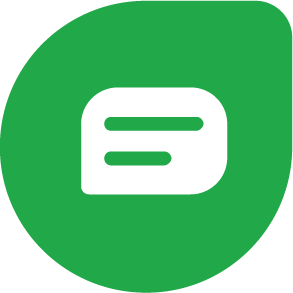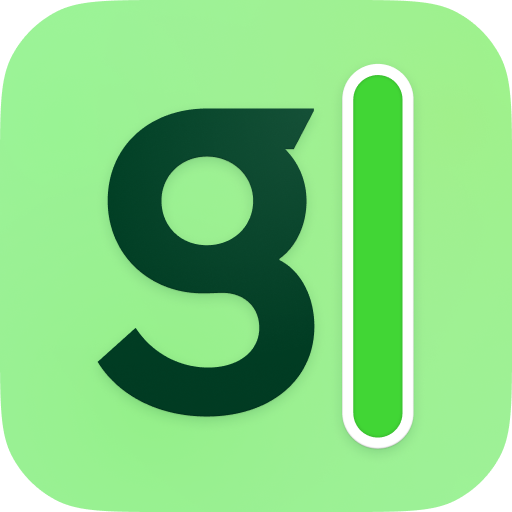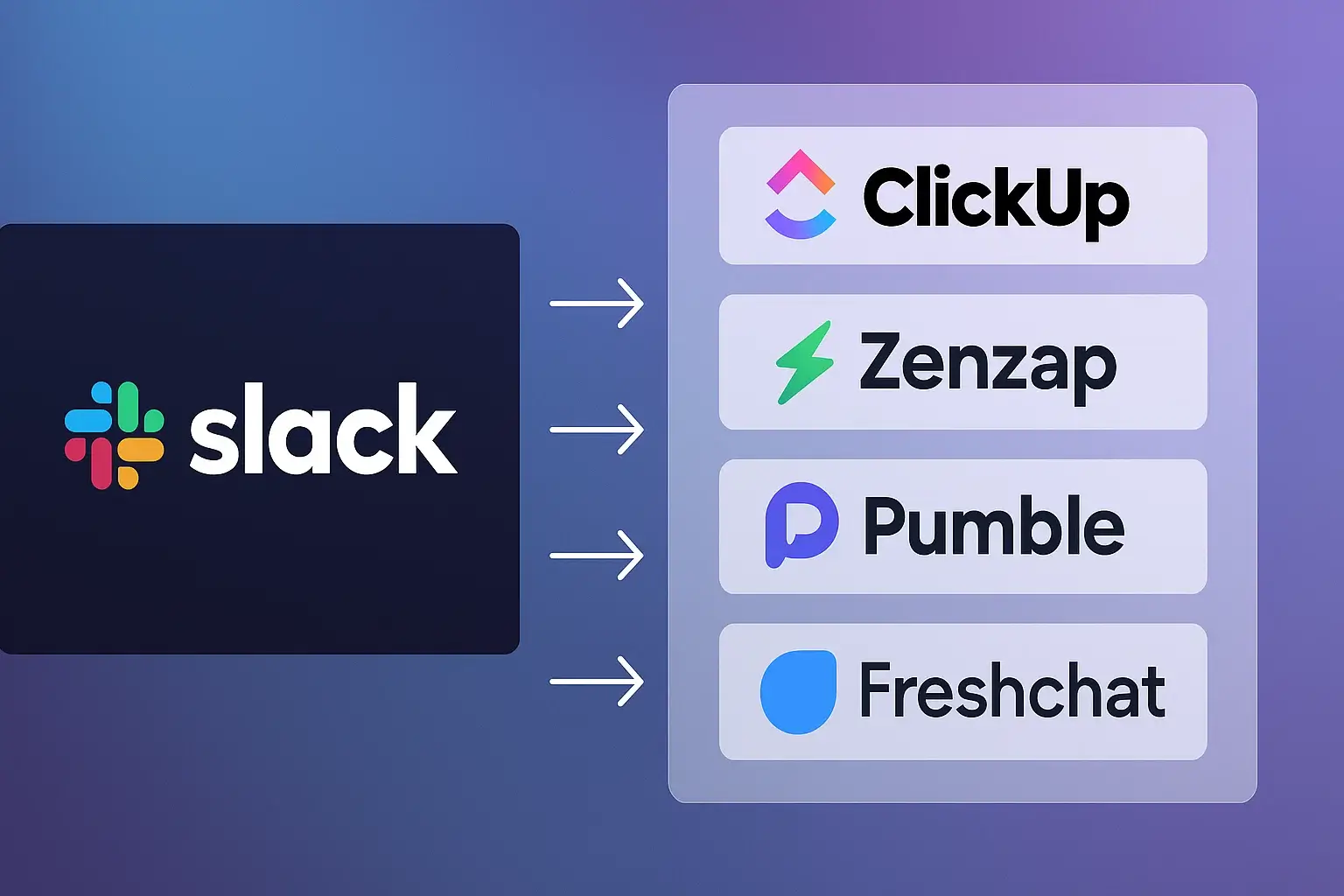
Introduction
If you’ve used Slack as your digital headquarters, you know how transformative real‑time messaging can be. Slack’s intuitive channels and robust integration ecosystem help bring conversations, files, and updates into one place. It supports asynchronous work with scheduled messages and reminders and fosters team culture through custom emojis and fun channels. However, as teams grow and workflows diversify, Slack’s limitations become more apparent.
You might feel overwhelmed by constant notifications, frustrated at paying a premium to unlock unlimited message history, or disappointed that Slack lacks built‑in task management. That’s why exploring alternatives is wise. Modern chat tools integrate messaging with tasks, calendars, and automation while offering competitive pricing. In this guide, you’ll discover four platforms, ClickUp Chat, Zenzap, Pumble, and Freshchat, that stand out as the best Slack alternatives in 2025, along with guidance on choosing the right one for your team.
Why Look for Slack Alternatives in 2025?
Slack excels at what it was built for: fast, flexible communication. Channels and threads keep conversations organised, and the platform’s search makes it easy to find any file, link, or message. With over 2,600 integrations, Slack connects seamlessly to tools like Google Drive, Trello, Zoom, and GitHub. It’s also easy to onboard new users thanks to its clean design and friendly Slackbot prompts.
Yet, there are reasons to explore alternatives:
- Notification fatigue: Without strict channel guidelines, Slack’s pings quickly become overwhelming and distracting. Important updates can get buried in a sea of messages.
- High per‑user pricing: Slack’s free tier limits you to 90 days of message history and 10 integrations. The Pro plan costs $7.25 per user/month, and the Business+ tier jumps to $12.50 per month, which adds up quickly for larger teams.
- Limited built‑in functionality: Slack doesn’t offer native project management or advanced voice/video conferencing; you need additional apps, increasing complexity.
- Thread confusion: When team members don’t use threads consistently, discussions spill into multiple channels and lose context.
Given these challenges, consider what features matter most to your team. Do you need integrated tasks and AI assistance, a mobile‑first design, customer‑facing chat, or simply a more affordable solution? The following tools approach chat from different angles and may align better with your workflows.
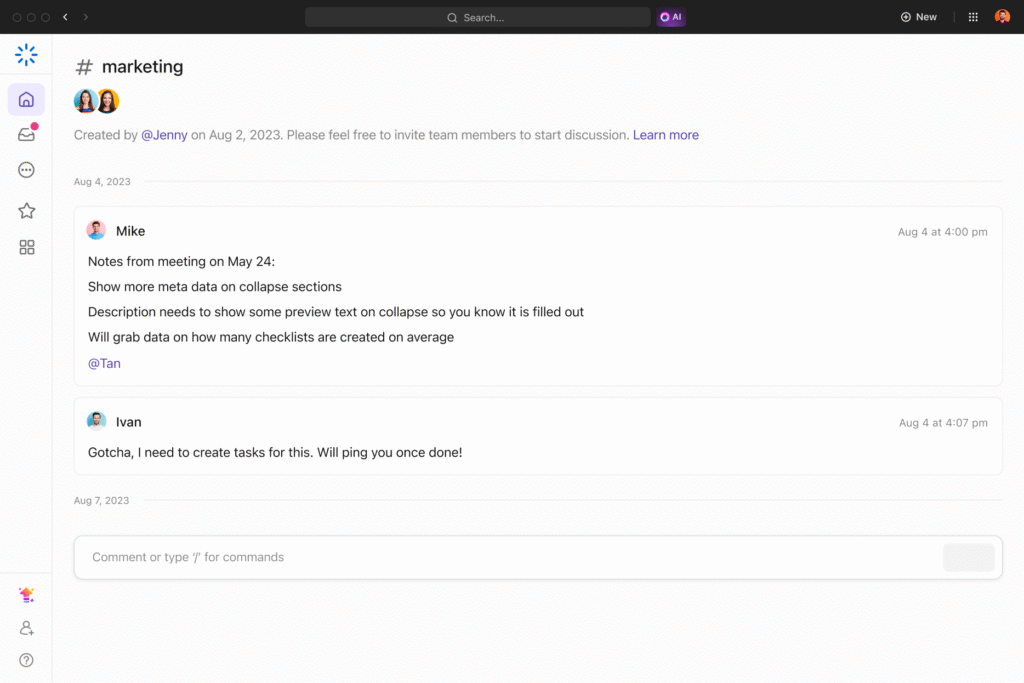
As part of ClickUp’s work management platform, ClickUp Chat embeds communication directly into your tasks, Docs, and dashboards. Instead of switching between Slack and your task board, you chat where the work happens. Each task or document has its own thread, so context is always clear.
Core Features & Advantages
- Unified workspace: You can discuss a task, share a Doc, or drop a file without leaving the item you’re working on. This reduces context switching and helps you stay focused.
- AI‑powered assistance: ClickUp’s AI summarises threads, suggests replies, and converts messages into tasks. For example, if a teammate asks you to “schedule the client call,” the AI can propose a task creation with the relevant due date.
- SyncUp calls with summaries: Launch voice or video meetings directly from chat and receive automated meeting summaries, saving time on note‑taking.
- Organised channels and threads: You can create channels for teams or topics and use threads for specific discussions—similar to Slack but without unnecessary feature bloat.
- Mobile performance: ClickUp Chat loads quickly on mobile devices, and you can join calls, respond to messages, or create tasks on the go.
- Generous free tier: The Free Forever plan includes chat, threads, voice/video SyncUps, and 100 AI credits per month. Even small teams get real value without spending a cent.
Limitations
Because ClickUp Chat is a feature within a broader work management platform, some chat‑centric features aren’t fully developed. You can’t pop out chat windows, customise notification settings deeply, or use emoji reactions extensively. New users may find ClickUp’s interface overwhelming until they understand how chat ties into tasks and Docs. AI features require credits that can run out quickly on the free plan.
Pricing & Who It’s For
ClickUp Chat comes with every ClickUp plan. The Free Forever tier costs nothing and offers full chat functionality with limited AI credits. The Unlimited plan at $10/user/month increases storage and AI credits, while the Business plan at $19/user/month adds advanced time tracking, workload views, and more AI credits. If your team already uses ClickUp or wants to centralise tasks and communication in one platform, ClickUp Chat is a top choice.
⚖️ Pros and Cons
Positive
✅ Chat is built into your actual work
✅ Eliminates tool-switching
✅ Great for structured, async teamwork
Negatives
❌ Overkill if you only need simple messaging
❌ The interface may feel busy for chat-first users
💡Final Thoughts on ClickUp Chat
If your team already uses ClickUp or wants an all-in-one productivity suite, this chat tool feels like a natural extension of your workflow. For teams that thrive on context and clarity, ClickUp Chat delivers communication that’s tied directly to outcomes.
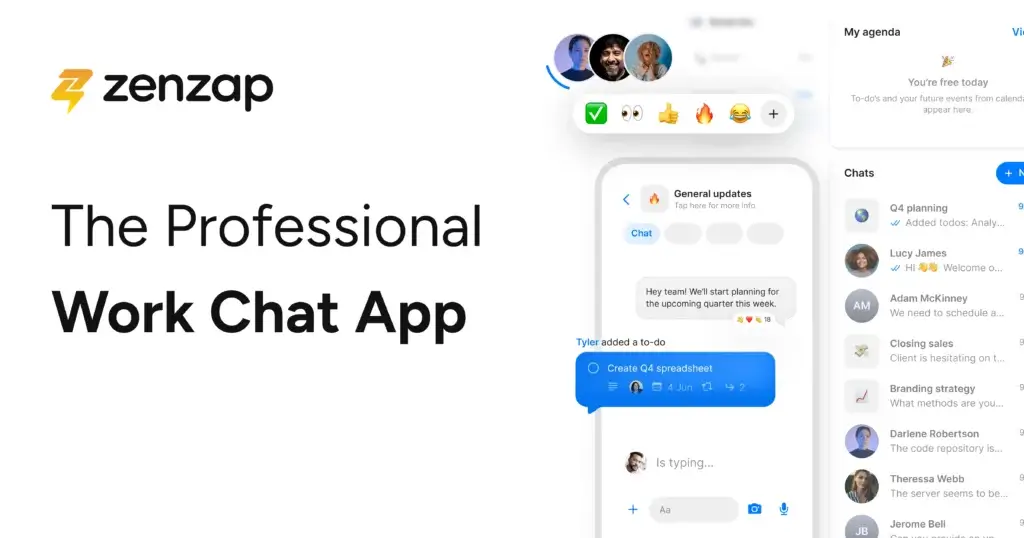
Zenzap is built for teams that prefer a streamlined, mobile‑first chat experience. It merges messages, tasks, and a calendar into one workspace so you can assign tasks directly from conversations and see them alongside your schedule. Think of it as Slack meets Trello, minus the clutter.
Core Features & Advantages
- Messaging + tasks + calendar: Turn messages into tasks with due dates and view them next to your calendar without switching apps. This integration helps you follow through on discussions.
- Streamlined interface & easy onboarding: Zenzap’s design is clean and familiar; onboarding includes templates, tooltips, and workspace presets, making it easy for non‑technical teams to get started.
- Affordable pricing: The Free plan includes unlimited messaging, calendar sync, and basic to‑dos. Paid plans begin at $3/user/month (Pro) and add advanced task features and integrations, while Business+ at $8/user/month offers role‑based access and audit logs.
- Cross‑platform consistency: Zenzap works smoothly on desktop, browser, and mobile, with reliable syncing across devices. There’s even a Chrome extension for quick task capture.
Limitations
Zenzap focuses on internal collaboration; there’s no customer‑facing live chat or support features. Its integration library is still growing, so you may need third‑party services for advanced connections. There are no AI bots or complex automations yet, and emoji customisation is basic.
Pricing & Who It’s For
Zenzap’s Free plan suits freelancers and small teams who need structured chat and task management. The Pro tier at $3/user/month unlocks advanced tasks and unlimited storage, while Business+ at $8/user/month adds security features like SAML SSO and audit logs. There’s also an Enterprise tier with custom pricing for large organisations. Zenzap is ideal for remote or field teams who prioritise mobility and want to keep messaging, tasks, and schedules together.
⚖️ Pros and Cons
Positive
✅ Ultra-simple, WhatsApp-style design
✅ Great for mobile teams or on-the-go chatting
✅ Includes file sharing and voice messaging
Negatives
❌ Custom emoji packs are limited
❌ Lack of messages that auto-delete after a while
💡 Final Thoughts on Zenzap
Zenzap isn’t trying to replace Slack or ClickUp – and that’s the point. If you need fast, secure, and no-fuss communication with your team or clients, Zenzap delivers it with a mobile experience that your whole team will instantly understand.
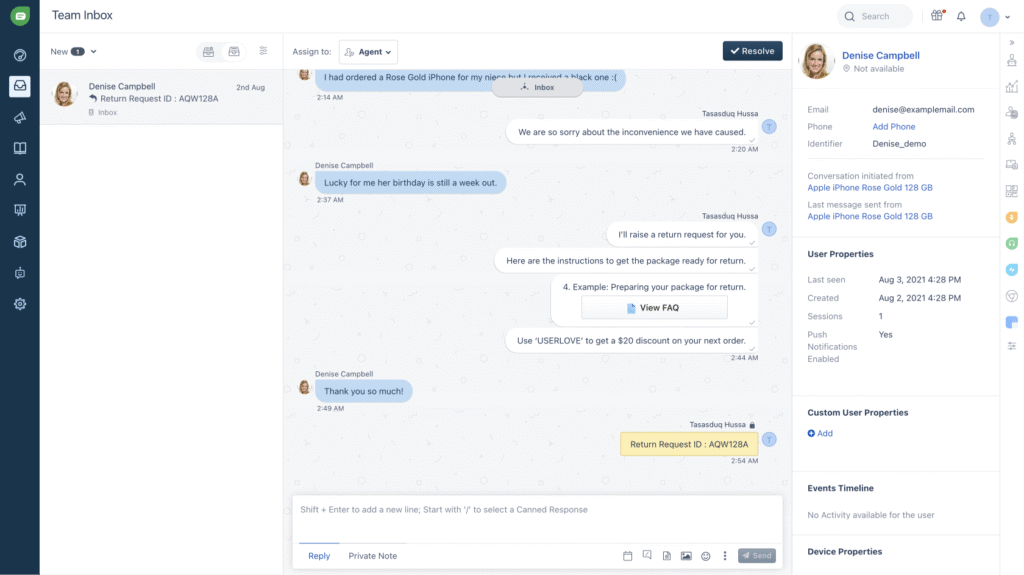
Freshchat, part of the Freshworks suite, is designed for businesses that communicate with customers or prospects across multiple channels. It evolved from a simple live chat widget into a fully integrated messaging platform that unifies website chat, mobile app chat, WhatsApp, Facebook, and Instagram conversations.
Core Features & Advantages
- Omnichannel inbox: Manage messages from your website, mobile apps, and social channels in a single dashboard. Agents can assign, reply, and close conversations without jumping between tools.
- Freddy AI automation: Freshchat’s Freddy AI helps qualify leads, suggest replies, and detect customer intent. This reduces repetitive work for your team and speeds up response times.
- User‑friendly interface: The dashboard is clean and intuitive; non‑technical users can get started without a steep learning curve.
- Comprehensive analytics: Freshchat provides both standard and custom reports to track resolution times, agent performance, and customer satisfaction.
- Flexible mobile apps: Agents can reply to queries, view notes, and assign chats via iOS and Android apps, with reliable push notifications.
Limitations
While Freddy AI is powerful, the chatbot builder lacks some advanced customisation options. There’s a learning curve for building complex automation workflows and using advanced reports. Freshchat doesn’t include a full ticketing system like Freshdesk, so support teams may need to integrate additional Freshworks products. Some features, such as advanced analytics and WhatsApp integration, are only available on higher‑tier plans.
Pricing & Who It’s For
Freshchat’s Free plan covers basic website chat for small teams. The Growth plan at $19/agent/month adds integrations with WhatsApp and Facebook, basic bots and automation; the Pro plan at $49/agent/month introduces Freddy AI bots, IntelliAssign (smart routing), and advanced analytics; the Enterprise plan offers custom pricing for organisations needing multi‑language support, IP whitelisting, and compliance controls. Freshchat is best for sales and support teams that require an omnichannel inbox and AI‑powered automation.
⚖️ Pros and Cons
Positive
✅ Built for engaging and converting customers
✅ Rich automation and reporting tools
✅ Scalable from startup to enterprise
Negatives
❌ More focused on customer chat than team collaboration
❌ Pricing scales per agent, which can add up
💡Final Thoughts on Freshchat
If your team spends a lot of time talking to leads and customers, Freshchat is an investment in speed, service, and scale. It transforms traditional live chat into a proactive revenue and support engine – not just a support box in the corner of your site.
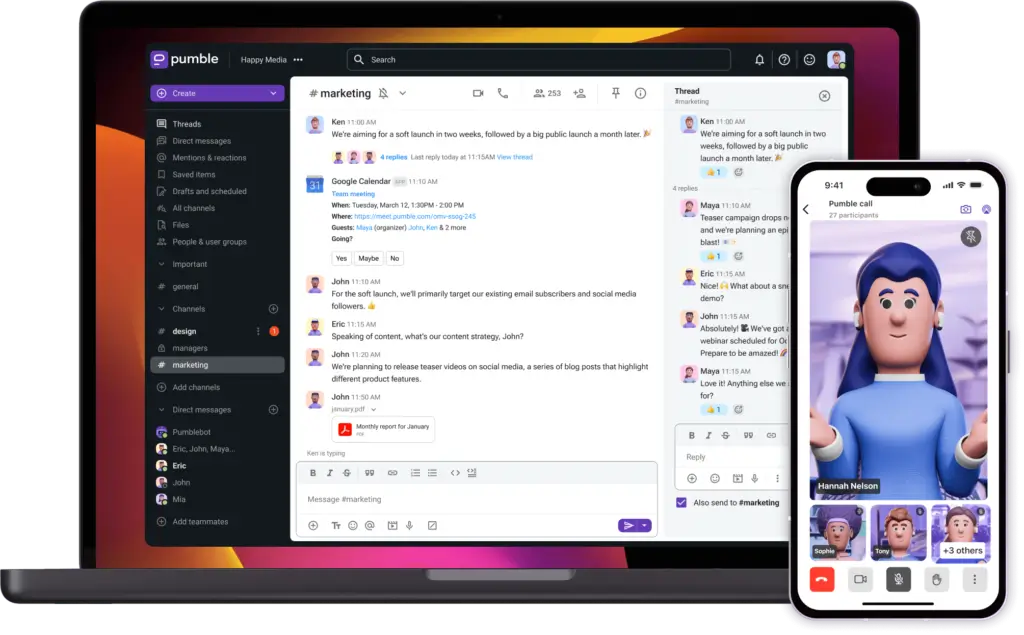
Pumble replicates Slack’s channel‑based chat but removes the paywall around message history. Developed by CAKE.com, Pumble’s free tier includes unlimited users and unlimited messages, making it attractive for startups and growing teams.
Core Features & Advantages
- Unlimited free tier: Most free chat tools limit message history, but Pumble lets you keep all your messages and add as many users as you like without paying.
- Stable, cross‑platform apps: Pumble is lightweight and runs smoothly on web, desktop, and mobile, with instant syncing across devices.
- Built‑in voice and video calls: You can launch 1:1 calls on the free plan; group meetings and screen sharing are available in paid tiers.
- Slack import: If you’re switching from Slack, Pumble’s import tool transfers your channels and message history in minutes.
- Affordable upgrades: Paid plans start at $2.49/user/month (Pro) and add group meetings for up to 50 participants, screen sharing, and more integrations. Business at $3.99/user/month introduces guest access, role permissions, and unlimited integrations, while Enterprise at $6.99/user/month adds SSO, data retention, and priority support.
Limitations
Pumble’s integration library is smaller than Slack’s; for many tools, you need a third‑party connector like Zapier. Group calls and screen sharing require a paid plan. UI customisation is limited, with only light and dark modes available. The free plan has a workspace‑wide storage limit of 10 GB, which may be restrictive for teams sharing large files. Pumble also lacks the vibrant community and app ecosystem that Slack enjoys.
Pricing & Who It’s For
Pumble’s Free plan is ideal for cash‑strapped startups or educational teams who need a reliable chat tool with unlimited history. The Pro tier at $2.49/user/month suits small teams requiring group calls and more integrations; Business at $3.99/user/month adds administration controls and larger storage; Enterprise at $6.99/user/month includes SSO and priority support. Choose Pumble if you want a Slack‑like interface with generous limits but don’t need extensive integrations.
⚖️ Pros and Cons
Positive
✅ Unlimited history on the free plan
✅ Affordable pricing for premium features
✅ Offers on-premise hosting for enterprises
Negatives
❌ Fewer integrations than bigger platforms
❌ Lacks deeper workflow tools
💡 Final Thoughts on Pumble
If your team just wants a clean, reliable space to chat and share, Pumble hits the mark. It’s ideal for growing teams who value simplicity, transparency, and budget-friendliness without sacrificing performance.
Quick Comparison Table
| Tool | Best For / Price From* | Standout Features |
| ClickUp Chat | Teams already using ClickUp; $10/user/month | Chat within tasks and Docs, AI summaries, SyncUp voice/video, integrated work management |
| Zenzap | Mobile‑first teams; $3/user/month | Chat within tasks and Docs, AI summaries, SyncUp voice/video, integrated work management |
| Pumble | Budget‑conscious teams; $2.49/user/month | Unlimited users & history, built‑in voice/video, Slack import, lightweight apps |
| Freshchat | Customer‑facing teams; $19/agent/month | Omnichannel inbox, Freddy AI chatbots, intuitive interface, detailed analytics |
How to Choose the Right Slack Alternative
Before committing to a new chat platform, consider these questions:
-
Is your primary need internal or customer‑facing communication? If you’re collaborating within your team, tools like ClickUp Chat, Zenzap, and Pumble are designed for internal messaging. If you handle customer support or sales chats, Freshchat’s omnichannel inbox and AI features are essential.
-
Do you need integrated tasks and project management? ClickUp Chat embeds messaging directly within tasks and Docs, while Zenzap allows you to turn messages into tasks and link them to your calendar. Pumble and Slack rely on integrations for task management.
-
Will your team work on mobile often? Field crews and remote workers benefit from Zenzap’s mobile‑first design. ClickUp Chat and Pumble also have solid mobile apps, but they’re designed primarily for desktop use. Freshchat’s mobile app is optimised for agents handling customer queries on the go.
-
What is your budget and team size? If you’re cost‑conscious, Pumble’s free tier with unlimited users and history is hard to beat. Slack’s per‑user pricing can become expensive at scale. ClickUp’s chat is free if you’re already using ClickUp; otherwise, you’ll need to subscribe to a plan. Zenzap and Freshchat offer low‑priced entry tiers, but they cater to different use cases.
-
Do you need extensive integrations or AI automation? Slack remains the champion for third‑party integrations. ClickUp and Zenzap have more focused ecosystems, while Pumble’s integration library is limited. For AI automation, ClickUp’s AI summarises conversations, and Freshchat’s Freddy bots handle customer queries.
Tip: If you’re looking for an all‑in‑one work platform that offers chat, task management, and powerful dashboards, consider Monday.com as well. Its Work OS integrates communication with projects, automation, and reporting. It’s particularly strong for teams that want a structured, visual way to manage work. You can learn more in our Monday.com Review.
For additional context, check out our related guides: 16 Best Task Management Software, 17 Best Project Management Software, and our detailed ClickUp Review. These articles provide broader overviews of productivity tools that integrate with or complement chat platforms.
Conclusion
Choosing the right Slack alternative hinges on understanding where Slack falls short for your team and what features matter most. ClickUp Chat integrates messaging directly with your tasks and documents, reducing context switching. Zenzap delivers a calm, mobile‑first workspace where chat, tasks, and calendar live together. Pumble provides unlimited users and message history on its free plan and remains budget‑friendly as you grow. Freshchat shifts the focus to customer‑facing conversations with an omnichannel inbox and AI automation.
As you evaluate these tools, consider the size and nature of your team, whether you need internal or external chat, how important integrated tasks and calendars are, and what your budget allows. And don’t forget to explore Monday.com and other work management platforms if you’re looking for an all‑in‑one solution. By aligning the right platform with your workflow, you’ll foster clearer communication, reduce app fatigue, and boost productivity in 2025 and beyond.
Frequently Asked Questions in 2025
-
Why should I replace Slack instead of improving how I use it?
You don’t necessarily need to replace Slack. However, if you’re constantly hitting the message limit, struggling with notification noise, or paying for features you don’t use, exploring alternatives could save money and improve productivity. Some tools integrate tasks and calendars directly, reducing context switching. -
Is migrating from Slack to another platform difficult?
Migration varies by tool. Pumble, for example, offers a Slack import feature that transfers channels and message history quickly. ClickUp and Zenzap require manual setup but benefit from built‑in task and calendar integration. Always export your data from Slack and follow the new platform’s migration guide. -
What’s the most affordable Slack alternative?
Pumble offers a truly free plan with unlimited users and message history. Zenzap’s Free plan includes unlimited messages and basic task management. ClickUp Chat is free within ClickUp’s Free Forever plan. Freshchat’s free tier is limited but still useful for basic web chat. -
Can I use these tools for video calls and meetings?
Yes. ClickUp Chat includes voice and video SyncUps. Pumble offers 1:1 calls on the free plan and group calls on paid plans. Zenzap supports voice notes but not full video conferencing. Freshchat focuses on chat and doesn’t provide general video meetings—your team will need a separate tool like Zoom for that. -
Which tool is best for mobile‑only teams?
Zenzap is designed with a mobile‑first mindset and offers consistent experiences across devices. Pumble’s lightweight apps and ClickUp’s mobile app are also reliable. Freshchat’s mobile app is excellent for customer support agents. -
Do these Slack alternatives support file sharing?
Yes. ClickUp Chat lets you drop files within tasks or Docs. Zenzap supports file attachments alongside tasks and calendars. Pumble includes file sharing on all plans. Freshchat allows attachments in its omnichannel inbox. -
Are there options for self‑hosting or enhanced security?
Pumble’s Enterprise plan offers SAML SSO and data retention controls. Zenzap’s Business+ plan adds role‑based access and audit logs. ClickUp and Freshchat offer enterprise‑grade security on their highest tiers. Always review a platform’s compliance certifications if you operate in regulated industries. -
Which tool has the best app ecosystem?
Slack still leads with over 2,600 integrations. ClickUp supports project management integrations and deeper native connections, but doesn’t match Slack’s ecosystem. Pumble’s integrations are limited. Freshchat integrates deeply with the Freshworks suite, but not with as many third‑party apps. -
Can I use multiple Slack alternatives together?
Yes. Some teams use ClickUp for project management and internal chat while using Freshchat for customer conversations, since Freshchat focuses on external messaging. Integration options vary by tool, so check if they can be linked via webhooks or third‑party services. -
Is Monday.com a chat tool?
Monday.com is primarily a work management platform, but it includes communication features like updates and team discussions. If you’re interested in combining chat, project management, and automation in one visual tool, Monday.com is worth exploring. Our Monday.com review explains how its Work OS supports collaboration across your entire organisation.


